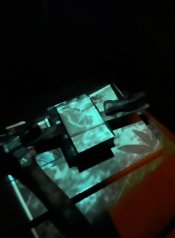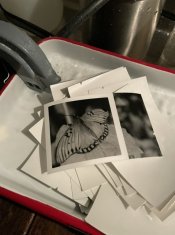eddie
Member
The setup…
I’m thinking about 20 three inch prints will take me through the range of sharpest focus. I’ll cut the sheets to three inches, mark a diagonal line across so I can reassemble them in order after processing. I will focus with 10 sheets in the film box. Then I will put 9 more sheets in the box and one in the home made speed ez-el. Expose, put the exposed sheet in the paper safe and take the next unexposed piece of paper out from under. Each exposure will lower the height of the film box under the speed ez-el by the thickness of one sheet of paper until they are done.
What if you took a sheet of clear film, mark an X with a sharpie on the right side of the film. On the left side, make an X on the reverse side of the film. Stick it in the enlarger and see if both Xs are in critical focus at the same time at 5.6 or 8. It would tell you if the offset of the film thickness is enough to make any difference.





